 Triumph Street Triple S - Service manual > Braking System Maintenance Safety Precautions
Triumph Street Triple S - Service manual > Braking System Maintenance Safety Precautions
Warning: Brake fluid is hygroscopic which means it will absorb moisture from the air. The absorbed moisture will greatly reduce the boiling point of the brake fluid causing a reduction in braking efficiency.
Replace brake fluid in line with the scheduled maintenance chart. A dangerous riding condition could result if this important maintenance item is neglected.
Do not spill brake fluid onto any area of the bodywork as this will damage any painted or plastic surface.
Always use new brake fluid from a sealed container and never use fluid from an unsealed container or from one which has been previously opened.
Do not mix different brands of fluid. Check for fluid leakage around brake fittings, seals and joints.
Check regularly for brake hose damage.
FAILURE TO OBSERVE ANY OF THE ABOVE WARNINGS MAY REDUCE BRAKING EFFICIENCY LEADING TO AN ACCIDENT.
Warning: If there has been an appreciable drop in the level of the fluid in either brake fluid reservoir, consult your authorised Triumph dealer for advice before riding.
If the brake lever or pedal feels soft when it is applied, or if the lever/pedal travel becomes excessive, there may be air in the brake lines or the brake may be defective.
It is dangerous to operate the motorcycle under such conditions and remedial action must be taken by your authorised Triumph dealer before riding the motorcycle.
Failure to take remedial action may reduce braking efficiency leading to an accident.
Warning: Use only DOT 4 specification brake fluid as listed in the general information section of this manual. The use of brake fluids other than those DOT 4 fluids listed in the general information section may reduce the efficiency of the braking system leading to an accident.
Failure to change the brake fluid at the interval specified in the scheduled maintenance chart may reduce braking efficiency resulting in an accident.
Warning: Never use mineral based grease (such as lithium or copper based grease) in any area where contact with the braking system hydraulic seals and dust seals is possible.
Mineral based grease will damage the hydraulic seals and dust seals in the calipers and master cylinders.
Damage caused by contact with mineral based grease may reduce braking efficiency resulting in an accident.
Front Brake Fluid Level Inspection - Daytona 675 and Street Triple R
Warning: Before starting work, ensure the motorcycle is stabilised and adequately supported. This will help prevent it from falling and causing injury to the operator or damage to the motorcycle.
In accordance with the scheduled maintenance chart, inspect the brake fluid level in the front and rear master cylinder reservoirs.
1. Ensure that the brake fluid level in the front brake fluid reservoir is between the upper and lower level lines (reservoir held horizontal).
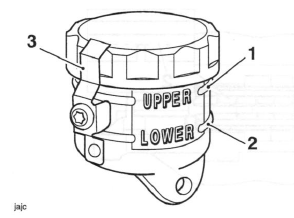
- Front reservoir upper level
- Front reservoir lower level
- Safety clip
2. To adjust the fluid level:
- Remove the safety clip.
- Fill the reservoir to the upper level line using new DOT 4 fluid from a sealed container.
- Refit the reservoir cover ensuring that the diaphragm seal is correctly fitted.
- Refit the safety clip.
Front Brake Fluid Level Inspection - Street Triple
Warning: Before starting work, ensure the motorcycle is stabilised and adequately supported. This will help prevent it from falling and causing injury to the operator or damage to the motorcycle.
In accordance with the scheduled maintenance chart, inspect the brake fluid level in the front and rear master cylinder reservoirs.
1. Ensure that the brake fluid level in the front brake fluid reservoir is between the upper and lower level lines (reservoir held horizontal).

- Front reservoir upper level
- Front reservoir lower level
2. To inspect the fluid level, check the level of fluid visible in the window at the front of the reservoir body.
3. To adjust the fluid level:
- Release the cap screws and detach the cover noting the position of the sealing diaphragm.
- Fill the reservoir to the upper level line using new DOT 4 fluid from a sealed container.
- Refit the cover, ensuring that the diaphragm seal is correctly positioned between the cap and reservoir body. Tighten the cap retaining screws.
Rear Brake Fluid Level Inspection - All Models
Warning: Before starting work, ensure the motorcycle is stabilised and adequately supported. This will help prevent it from falling and causing injury to the operator or damage to the motorcycle.
In accordance with the scheduled maintenance chart, inspect the brake fluid level in the front and rear master cylinder reservoirs.
1. Ensure that the brake fluid level in the rear brake fluid reservoir is between the upper and lower level lines (reservoir held horizontal).
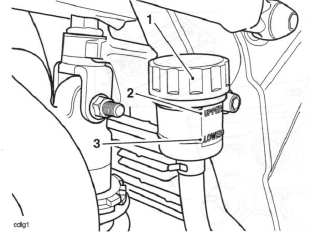
- Rear reservoir
- Rear reservoir upper level
- Rear reservoir lower level
Changing Brake Fluid
Brake fluid should be changed at the interval specified in the scheduled maintenance chart.
Brake Pads
Front and rear pad wear is automatically compensated for and has no effect on brake lever or pedal action.
Brake Wear Inspection
In accordance with the scheduled maintenance chart, inspect the brake pads for wear. The minimum thickness of lining material for any front or rear brake pad is 1.5 mm. If any pad has worn to the bottom of the groove in the pad centre, replace all the brake pads on that wheel.

- Lining material thickness
- Centre groove
Warning: Do not replace individual brake pads, replace both pads in the brake caliper. On the front where two calipers are mounted on the same wheel, all the pads in both calipers must be replaced together. Replacing individual pads will reduce braking efficiency and may cause an accident.
Bleeding the Front Brakes, Renewing Brake Fluid
Warning: Before starting work, ensure the motorcycle is stabilised and adequately supported. This will help prevent it from falling and causing injury to the operator or damage to the motorcycle.
Note:
- Daytona 675 and Street Triple R only: The master cylinder
should always be bled last.
Bleed each caliper in turn before bleeding the master cylinder.
1. Note the original setting of the brake lever adjuster in order that it can be returned to the same position when the bleeding operation is complete. Set the brake lever adjuster to position No.1.
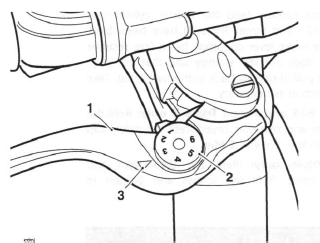
- Lever (Daytona 675 shown)
- Adjuster wheel
- Triangular mark
2. Turn the handlebars to bring the fluid reservoir to a level position.
Warning: Ensure absolute cleanliness when adding brake fluid to the brake fluid reservoir. Do not allow moisture or debris to enter the cylinder, as this will adversely affect the fluid properties. Always use fluid from a sealed container and do not use fluid from a container that has been opened for any period of time. Always check for fluid leakage around hydraulic fittings and for damage to hoses. A dangerous riding condition leading to loss of motorcycle control and an accident could result if this warning is ignored.
Caution: To prevent paint damage, do not spill brake fluid onto any area of the bodywork. Spilled brake fluid will damage paintwork.
3. Daytona 675 and Street Triple R only: Remove the screw from the reservoir cover and collect the safety clip.
4. Carefully remove the reservoir cover taking care not to spill any fluid.
5. Street Triple only: Release the cap screws and detach the cover noting the position of the sealing diaphragm.
6. All models: Check the condition of the sealing diaphragm for the reservoir. Replace if necessary.
7. Remove the rubber cap from the bleed nipple on the right hand caliper.
8. Attach a transparent tube to the bleed nipple and place the other end of the tube in a suitable receptacle containing new brake fluid. Keep the tube end below the level of fluid.
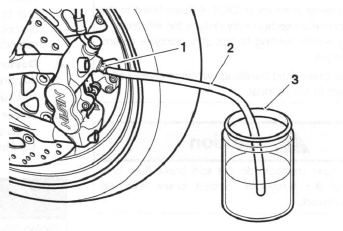
- Bleed nipple (Daytona 675 shown)
- Bleed tube
- Container
9. Release the bleed nipple.
Note:
- During bleeding, do not allow the fluid level to fall below the lower level mark in the reservoir. If the fluid level is allowed to fall below this mark, air may enter the system and the sequence of bleeding must be repeated.
10. Get an assistant to slowly pull the brake lever to the handlebar.
11. With the lever held fully against the handlebar, close the bleed nipple. Once the bleed nipple is closed, release the brake lever.
12. Repeat steps 10 and 11 until no more air appears in the bleed tube.
13. When all air has been expelled from the system, hold the lever fully against the handlebar and close the bleed nipple.
Note:
- Maintain the brake fluid level between the upper and lower reservoir levels whilst bleeding is being carried out.
14. Tighten the bleed nipple to 6 Nm.
15. Remove the bleed tube.
16. Replace the bleed nipple cap.
17. Fill the reservoir to the upper level with new DOT 4 fluid.
Warning: Use only DOT 4 specification brake fluid as listed in the general information section of this manual. The use of brake fluids other than those DOT 4 fluids listed in the general information section may reduce the efficiency of the braking system leading to loss of motorcycle control and an accident.
Observe the brake fluid handling warnings given earlier in this section of the manual.
Caution: To prevent paint damage, do not spill brake fluid onto any area of the bodywork. Spilled brake fluid will damage paintwork.
18. Repeat the bleed procedure for the left hand caliper.
19. Daytona 675 and Street Triple R only: Repeat the bleed procedure for the bleed nipple on the master cylinder. Tighten the bleed nipple to 6 Nm.
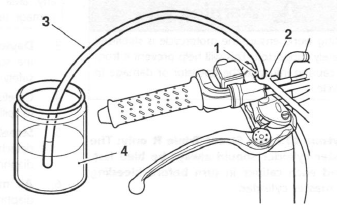
- Bleed nipple (Daytona 675 shown)
- Spanner
- Bleed tube
- Container
20. When both calipers (and the master cylinder on Daytona 675 and Street Triple R) have been bled, ensure the brake lever operation has a firm resistive feel to it, does not feel spongy and that the lever cannot be pulled directly back to the handlebar. Take remedial action as necessary.
21. Daytona 675 and Speed Triple R only: Refit the diaphragm and reservoir cover. Refit the safety clip and tighten the screw to 1 Nm.
22. Street Triple only: Refit the diaphragm and reservoir cover. Refit the screws and tighten to 1.5 Nm.
Warning: Always return the lever adjuster to the original setting as noted in paragraph 1. Operating the motorcycle with lever settings that are unfamiliar may lead to loss of control or an accident.
23. All models: Reset the brake lever adjuster to the original setting.
24. Check the operation of the front brake. Rectify as necessary.
Warning: It is dangerous to operate the motorcycle with defective brakes; you must have your authorised Triumph dealer take remedial action before you attempt to ride the motorcycle again. Failure to take remedial action may reduce braking efficiency leading to loss of motorcycle control and an accident.
See also:
 Triumph Street Triple S - Service manual > Brakes
Triumph Street Triple S - Service manual > Brakes
Exploded View - Front Brake Master Cylinder - Daytona 675 and Street Triple R
 Triumph Street Triple S - Service manual > Front Brake Pads
Triumph Street Triple S - Service manual > Front Brake Pads
Front Brake Pads - Daytona 675 up to VIN 381274 and Street Triple R Removal Warning: Before starting work, ensure the motorcycle is stabilised and adequately supported. This will help prevent it from falling and causing injury to the operator or damage to the motorcycle.

 Benelli Imperiale 400
Benelli Imperiale 400 BMW F900XR
BMW F900XR Honda CB500X
Honda CB500X KTM 390 Adventure
KTM 390 Adventure Triumph Street Triple S
Triumph Street Triple S Yamaha MT-03
Yamaha MT-03 Kawasaki Z400
Kawasaki Z400 Triumph Street Triple S
Triumph Street Triple S Yamaha MT-03
Yamaha MT-03